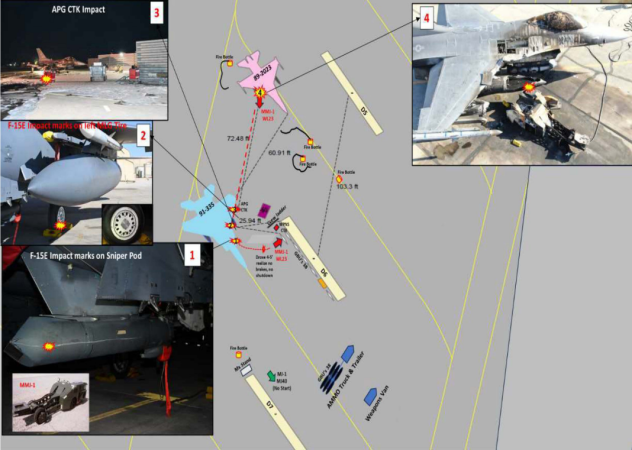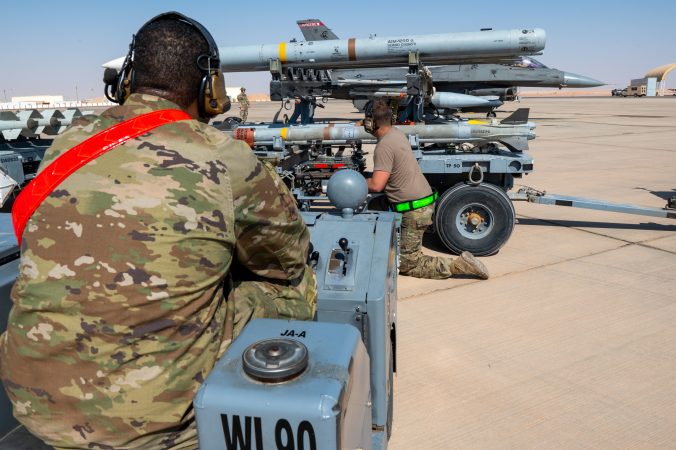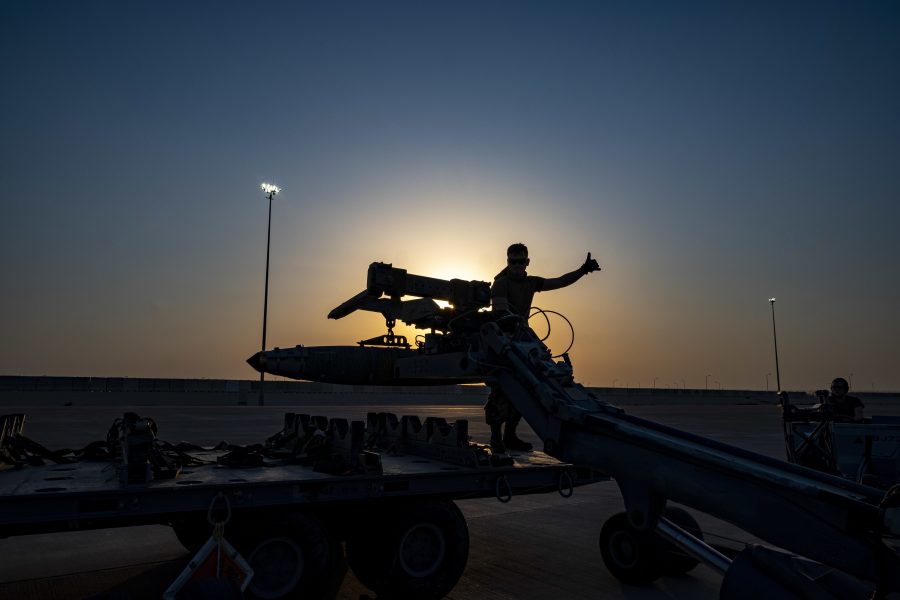A runaway bomb lift rammed into a parked U.S. Air Force F-16 deployed to the Middle East last November, sparking a blaze that caused $30 million in damages, according to a new USAF report.
The accident investigation board report, released by U.S. Air Forces in Europe last week, faults a maintainer for losing situational awareness and panicking, causing him to hit the accelerator on the weapons loader instead of the brake, as the main cause of the mishap. The investigation also found a lack of proper documentation for the bomb lift vehicle fleet at the installation, as well as “a loose culture of adherence to Air Force standards and technical procedures” among maintainers there.
The report comes on the heels of the Air Force rolling out new “privileged safety information” training to maintainers, citing an increase in ground mishaps involving maintenance, aircraft towing, and other flight line work. The new training gives maintainers access to the full picture of mishap events—including factors, findings, causes, and recommendations—so long as they sign a nondisclosure agreement.
The Nov. 17, 2023 mishap took place at an undisclosed location in the Middle East, involving an F-16 from the 31st Fighter Wing at Aviano Air Base, Italy, and maintainers and an F-15E from the 48th Fighter Wing at RAF Lakenheath, U.K. Around a month earlier, the Air Force deployed F-15Es and other fighters to the region to bolster its presence after Hamas’ attack on Israel.
The incident took place as a three-person crew of maintainers were swapping out munitions on the F-15E due to new mission requirements. As the crew was preparing to load new munitions, the crew chief instructed the weapons loader to move the bomb lift, also called a jammer. After disengaging the parking brake and shifting into reverse, the maintainer stated he only went five feet before he realized he could not stop the vehicle.
As the maintainer tried to hit the brakes and engage the parking brake, the bomb lift kept going backward and hit a sniper pod on the F-15E. The impact knocked the maintainer unconscious, and the loader then hit the aircraft’s landing gear and started heading towards a toolbox. The maintainer fell off the loader, and after hitting the toolbox, the vehicle redirected again and traveled 60 feet before hitting the F-16 on its right external fuel tank. A fuel leak sparked a blaze that destroyed the loader and significantly damaged the fighter.

Investigators found numerous maintenance issues leading up to the accident:
- The crew attempted to use two other weapons loaders; one did not start, and the other had gear shifting issues halfway through the munitions swap, leading them to swap out for the mishap vehicle.
- A lack of required documentation for inspections and needed safety fixes
- A trend of maintainers taking better care of weapons loaders that they brought with them when deployed than the weapons loader stationed permanently at the location. The loader involved in this mishap was permanently stationed at the location.
- The maintainer driving the loader at the time of the mishap was fully qualified but not proficient at operating that particular model during a live loading operation and did not know all steps of the emergency shutdown procedures.
- Miscommunication about a new takeoff time led to the crew rushing “under quicker than anticipated time constraints.”
As for the mishap itself, investigators noted that different models of the MJ-1 jammer have different configurations for their brake and accelerator pedals. Given the maintainer’s lack of current proficiency, the fact that he did not recall what model he was operating, and analysis of the vehicle determining a catastrophic failure of the brakes was unlikely, they found it “more likely than not that [the maintainer] was engaging the accelerator pedal when he thought he was engaging the brake pedal.”
As he traveled backward, the maintainer could have stopped the loader by engaging the brake, pressing the ignition button, or pushing the throttle cable all the way in—all procedures outlined for an emergency shutdown. Instead, he kept hitting the accelerator, thinking it was the brake pedal.
From there, officials surmised that the impact of the loader on the F-15E’s landing gear likely caused the jammer’s hydrostatic drive pump to get stuck in the reverse position, citing impact marks on the pump. This caused it to keep going even after the maintainer fell off the vehicle. The drive pump’s issues were not helped by the fact that investigators found “significant and extensive corrosion” on the part.

Investigators noted that the F-16 sustained “extensive” damage and that its external fuel tank was destroyed in the fire. The F-15E escaped major damage, with only an external scratch on its sniper pod.
Several accident investigation board reports in recent months have noted issues with maintainers contributing to mishaps, though air crew have often been cited for mistakes in those same incidents.
In September 2023, a contractor walked into the moving propeller of an MQ-9 drone during ground tests last year, and an investigation found she was not properly trained on how to approach a running aircraft, had received conflicting guidance about the no-enter zones around the drone, and was unfamiliar with the handheld device she was operating at the time of the accident.
In August 2023, ground crew assigned to marshal a CV-22 failed to use standardized language or signals or the necessary daylight-fluorescent wands, while the co-pilot misjudged the distance to another parked Osprey, causing them to collide.
In May 2023, maintainers were cited for failing to prevent an F-15’s hydraulic failure, which led to an in-flight emergency and ended with pilot and air traffic controller errors causing the aircraft to crash into a ditch at the end of a runway.


